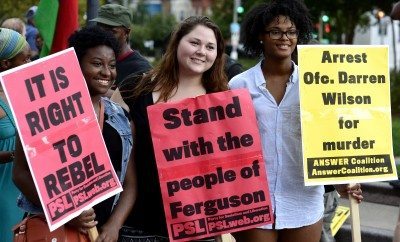 Image courtesy of [Beth Cortez-Neavel via Flickr]
Image courtesy of [Beth Cortez-Neavel via Flickr]
Law
Community Justice: Can It Improve America’s Criminal System?
As concerns grow over the ethics of our nation’s police forces, there’s been talk alternatives to the current approach. One of those alternatives is a concept called “community justice.” But can community justice actually bring change and provide alternative solutions to traditional policing methods? Read on to learn about community policing and the court, and what these practices can bring to the table.
What is community justice?
Community justice is a broad term that includes practices for combating crime that directly or indirectly involve the community. The main goal is to enhance community life through problem-solving strategies, restore victims’ quality of life, reintegrate offenders, and strengthen normative standards in the community.
Community justice can be seen as a non-traditional model to deal with crime and disorder, as it creates a dialogue between citizens, community organizations, and criminal justice agencies. The focus is on the outcome for the community as a whole, not on individual cases. According to this perspective, crime is a community issue, and therefore, residents’ engagement is paramount in addressing it. Community justice advocates argue that stability can be achieved through partnership between the citizenry and law enforcement, or even through autonomous efforts of community residents.
Community justice is more of a theoretical concept than a practical tool, which gives practitioners a broad range of options when developing and implementing community justice practices. Generally, there are five avenues to pursue community justice initiatives: crime prevention, policing, prosecution, adjudication, and corrections. Some practices can fall into several categories simultaneously. As of now, community policing and community courts are two of the most widespread practices.
What is community policing and how does it work?
Community policing, sometimes called problem-oriented policing, emphasizes crime prevention through active engagement between communities and police officers. Community policing focuses on crime issues specific to a certain neighborhood. The issues can range from the presence of habitual offenders to violent youth gangs or open drug markets. Sometimes community policing focuses on tackling issues such as vandalism, loitering, drunk driving, unwanted noise, litter, or abandoned vehicles.
Community policing uses non-enforcement and trust-building tactics to engage residents, including youth, to partner with law enforcement in tackling local public safety issues. The practices can vary greatly, but the most common include:
- Neighborhood meetings with police officers present and actively participating;
- The development of collaborative action plans where police officers and citizens work together to resolve local safety issues;
- Crime prevention through environmental design (CPTED). This means rebuilding neighborhoods by employing designs that fit the needs of a specific community and take into consideration its safety concerns;
- Assignment of officers to fixed locations and shifts so they can establish more personal relationships with community residents; and,
- Police engagement with public schools through direct instructions from an officer, or in the form of a school resource officer who is constantly present in the vicinity.
Watch the video below to learn about community policing in Long Beach, California.
Building trust, is perhaps the most important goal of community policing, as it creates a different dynamic in the neighborhood. Advocates believe that traditional policing often just creates fear. It’s believed that the active participation of community residents legitimizes police work and helps to maintain trust and reduce crime at the same time. In the long run, it can alter criminal justice policies and establish new professional norms in police departments across the country.
History of Community Policing
The inception of community policing can be traced to the 1800s when Sir Robert Peel pioneered the practice in one of London’s Police Departments. The United States took up the innovative approach and adhered to it until the beginning of the 20th century. However, with changes to technology like police cars and mobile phones, policies changed too. Slower paced and labor-intensive community policing was abandoned.
Its revival began in the 1970s, when several police departments employed more progressive practices, some of which contained elements of community policing, such as building public support and engaging citizenry. Since that time, community policing unequivocally has become a more common modus operandi in police departments across the country. Many state jurisdictions have either community policing units or employ community-oriented practices as strategies to maintain public safety and fight crime. Practices vary greatly, but all involve public outreach in one way or another. Since its inception, community policing in the United States has been supported by non-profit organizations, government agencies, and rendered various partnerships. Among the most important are the following.
- The Community Policing Consortium (CPC) was an early initiative to establish community policing as a legitimate practice. The CPC was founded by the Bureau of Justice Assistance, and is essentially a five-way partnership between the leading police associations and forums in the country. Its focus is to provide technical assistance and training materials to police departments.
- The Center for Problem Oriented Policing (POP) was established in 1999, and played a leading role in cultivating community policing practices in the United States. It is comprised of researchers, police practitioners, and academics.
- Community Oriented Policing Services (COPS) is a federal agency that operates under the Department of Justice. COPS assists with grants and with practical implementation of community policing practices. COPS’ initiatives include Making Officer Deployment Effective; Distressed Neighborhoods; Problem Solving Partnerships; Tribal Government Resource Grants; Domestic Violence Grants; Meth-amphetamine Initiatives; Technology Adoption; Justice-Based After School Activities; and Anti-Gang Initiatives.
In March 2015, Attorney General Eric Holder announced a $4.75 million pilot community policing initiative. The project will be called the National Initiative for Building Community Trust and Justice, and will run in Birmingham, Alabama; Fort Worth, Texas; Gary, Indiana; Minneapolis; Pittsburgh; and Stockton, California.
What are the benefits of community policing?
Community policing is a completely different approach to criminal decisions and the actors involved. It rethinks the role of law enforcement, fundamentally changing the outcome of an everyday police encounter by building trust and respect between police officers and citizens. Community policing in a way is a crime prevention tool as it targets the root of the problem and heals the wounds of the community by creating an atmosphere of trust and support, not fear and retribution.
What are community courts and how do they work?
Community courts are neighborhood-centered courts that address problems of a specific community. All community courts are official arms of the justice system, with the appropriate jurisdiction to handle certain types of crime. Community courts can be multi-jurisdictional, have just one jurisdiction, or act as specialized courts that focus on issues such as drugs, domestic violence, and mental health. Community courts often involve local organizations, churches, businesses, social service providers, criminal justice agencies, and community members to create new and innovative approaches to deal with local crime issues.
Community courts mostly deal with low-level habitual offenders, the so-called frequent flyers, who are responsible for quality-of-life crimes that are non-violent and low-level offenses. These can include loitering, panhandling, shoplifting, and trespassing. Frequent flyers usually reoffend because there are no mechanisms in place to help solve their problems. They cycle in and out of the system, breeding poverty and more crime.
The purpose of community courts is to break this cycle of crime in the community, aid victims, and rehabilitate offenders. To reach these goals, community courts use a mixture of traditional and non-traditional practices. Instead of putting offenders back into the prison system without offering aid, community courts provide a helpful alternative, often through drug treatment or job-readiness programs. Some community courts use mediation, job training and placement, drug treatment, homeless outreach, substance abuse, HIV prevention, and tutoring programs for youth. As a result, offenders pay back the community by working in the neighborhood in partnership with local organizations. This allows for better integration of offenders into the community. If an offender complies, he receives the benefit of social services, while if he fails, he will be brought back to the traditional court system for adjudication. By sentencing fewer people to incarceration and increasing the numbers of those who can remain within communities, community courts are building up mutual trust, which in turn can result in solving crime problems in that specific neighborhood.
History of Community Courts
Community courts are a later phenomenon than community policing. The first community courts in the country can be traced to the early-to-mid 1990s, but they stalled due to the nation’s “tough on crime” policies. Recently, community courts were revived as an alternative to traditional adjudication practices, mostly due to the negative effects of the “tough on crime” era, and the overcrowding of American prisons. As of 2014, there were 40 community courts in 14 states, including Minnesota, New Jersey, Connecticut, and Washington, D.C. New York City is the leader in the number of community courts, hosting six within its borders.
No two community courts are alike as each is unique in its structure and the programs it provides. Among the most prominent and effective are the following.
- The Midtown Community Court was established in 1993, and was the first court of its kind. It played a pivotal pole in cleaning up Times Square, which was at the time a frequent meeting place for prostitutes and drug dealers. Midtown Community Court heard more than 21,000 cases in 2013 alone, and yearly saves New York City $1.2 million by handling low-level offenders.
- The Hartford Community Court was created in 1998, and was the first program designed to apply to the entire city, including urban and suburban communities. It has a community service hot line, and even offers a quarterly newsletter through which offenders report back to the community about their successes.
- Launched in 2000, the Red Hook Community Justice Center was the first multi-jurisdictional community court in the United States. It also has a youth court, where teenagers resolve cases pertaining to their peers. Watch the video below to learn more about the community court in Red Hook, Brooklyn.
- Started in 2008, the Orange County Community Court is comprised of a veterans court, drug court, mental health court, DUI court, and homeless outreach court. All these specialized courts are housed in the same facility, making it convenient to screen and refer offenders to appropriate social services and treatment programs.
- The San Francisco Community Justice Center, launched in 2009, adjudicates misdemeanor and non-violent felony cases in four neighborhoods: Tenderloin, South of Market, Union Square, and Civic Center. It provides drug and mental health treatment, support groups, counseling, career development, and job training. .
Watch the video below to learn more about other community courts and their innovative approaches.
What are the benefits of community courts?
Community courts improve the quality of life in a neighborhood and reshape social norms of those community members who have committed crimes. They build up trust between community members and the justice system, reduce fear, and contribute toward more fair and accountable adjudication practices.
Community courts also provide quicker and cheaper alternatives to the traditional court system as they uses judges, not juries. At a community court, a defendant can see a judge, receive punishment, and connect with a social worker all in one day.
These programs can free traditional courts from dealing with petty crimes, allowing them to focus on serious offenders instead. As a result, the prison population and costs associated with incarceration and the adjudication process decrease. It’s hard to assess if community courts are the cause of reductions to recidivism and crime rates, but the overall compliance with court practices is high, and the public tends to support community courts even if it means higher taxes. As an example, while Red Hook Community Court sent only one percent of all defendants to jail, its traditional counterpart, Brooklyn Criminal Court, incarcerated 15 percent of its defendants. Even if 78 percent of guilty defendants in the Red Hook Community Court receive ongoing supervision through mental health and drug treatment, it’s still a cheaper option than sending them to correction facilities.
Conclusion
Community justice is already fostering positive changes. Can it be a solution to the growing incarceration rates and police discontent? It certainly seems possible, as community justice successes continue to spring up. Each community has its unique concerns and crime problems, thus, a community justice approach can be a good fit to serve the needs of individual neighborhoods better than any sort of one-size-fits-all approach. By imposing meaningful sanctions on offenders, building trust between police and residents, and forming genuine problem-solving alliances, our criminal justice system may have the opportunity to change for the better.
Resources
Primary
National Criminal Justice Reference Service: Community Justice: A Conceptual Framework
New York Courts: Problem-Solving Courts
Additional
Central Valley Business Times: Stockton Picked For Unique Community Justice Program
Center for Court Innovations: Community Courts
Center For Court Innovations: Midtown Community Court
Center For Court Innovations: Red Hook Community Justice Center
Center for Court Innovations: Mentor Courts
Center for Court Innovations: Hartford Community Court: Origins, Expectations and Implementation
Daily News: Red Hook Community Court is a Success for Defendants and Taxpayers
Big Story: Novel Courts Handle Low-Level Crimes Across U.S
Christian Science Monitor: Community Courts Let the Punishment Fit the Crime, Compassionately
Wall Street Journal: What to Know About Community Policing
What-When-How: Community-Oriented Policing
USA Today: Alternative Courts Gain Ground For Petty Criminals








Comments